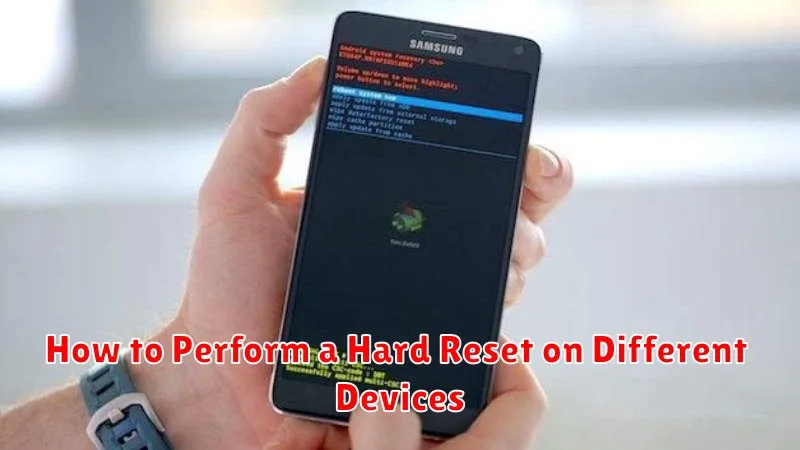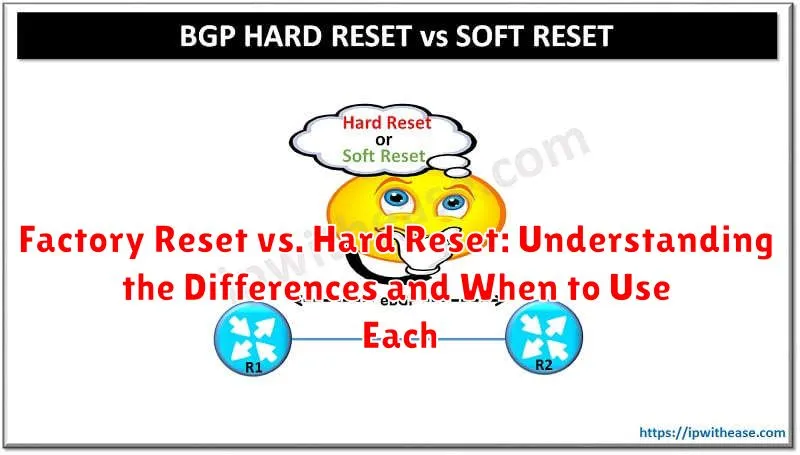When troubleshooting tech issues, you’ll often encounter the terms “factory reset” and “hard reset“. While they might sound similar, they represent distinct processes with varying implications for your devices. Understanding the differences between a factory reset and a hard reset is crucial for effective troubleshooting and data management. This article will delve into the specifics of each, clarifying their functionalities, exploring when to use each method, and guiding you toward the best solution for your specific needs. Learn the crucial differences between a factory reset and a hard reset to effectively resolve your tech problems.
Are you facing a sluggish device, persistent software glitches, or preparing to sell your gadget? A factory reset or a hard reset might be the solution. This article will guide you through the process of determining whether a factory reset or a hard reset is the appropriate course of action. We will explore the differences between these two procedures, outlining when to utilize each and the respective outcomes. By understanding the nuances of a factory reset versus a hard reset, you can effectively address your tech problems and ensure the smooth operation of your devices.
What is a Factory Reset?
A factory reset, also known as a master reset, is a software-based process that returns a device to its original settings as it was when it left the factory. It erases all user data, including downloaded apps, photos, videos, music, and customized settings.
This process effectively wipes the device clean and reinstalls the operating system. Think of it like formatting a hard drive on a computer. After a factory reset, the device is essentially like new, requiring the initial setup process as if it were just purchased.
Factory resets are typically initiated through the device’s settings menu. The exact process varies depending on the operating system and device manufacturer, but the end result is the same: a clean slate.
What is a Hard Reset?
A hard reset, also known as a force restart or cold reboot, is a more abrupt method of restarting a device. It involves cutting off power to the device completely and then restarting it. This bypasses the normal shutdown process and forces the hardware to restart from a base state.
Think of it like flipping the power switch on a lamp. You’re not gracefully turning off the light; you’re directly interrupting the electrical flow. Similarly, a hard reset directly interrupts the device’s operations, forcing it to power down and back up.
Hard resets are often necessary when a device becomes completely unresponsive or frozen, and you cannot perform a regular restart or factory reset through the software interface.
Key Differences Between Factory Reset and Hard Reset
While both factory and hard resets restore a device to its original state, they differ in how they achieve this and the scope of their impact.
A factory reset is a software-driven process, typically initiated through the device’s settings menu. It erases user data and settings, returning the device to its out-of-the-box configuration. The operating system remains intact, though it reverts to its original version.
A hard reset, also known as a force reset, is a hardware-level reset. It often involves a specific button combination and bypasses the operating system entirely. It typically clears more fundamental settings and can sometimes resolve issues a factory reset cannot.
| Feature | Factory Reset | Hard Reset |
|---|---|---|
| Method | Software-initiated | Hardware-initiated |
| Scope | User data and settings | More fundamental settings, including OS in some cases |
| Operating System | Retained, reverted to original version | May be impacted or reinstalled (depending on device) |
When to Perform a Factory Reset

A factory reset is a useful tool in various situations where you need to restore your device to its original software state. Consider a factory reset when you experience the following:
Software Glitches and Performance Issues
If your device is running slowly, freezing frequently, or experiencing persistent software problems that you can’t resolve through other troubleshooting methods, a factory reset can often rectify these issues.
Selling or Giving Away Your Device
Before selling or giving away your device, a factory reset is crucial for protecting your personal data. It removes all your accounts, files, and settings, ensuring the new user receives a clean slate.
Pre-Ownership Transfer
Similar to selling a device, if you are transferring ownership within a family or organization, a factory reset is recommended to remove personal information and configure the device for the new user.
Removing Malware or Viruses
While not always a guaranteed solution, a factory reset can sometimes help eliminate malware or viruses that have infected your device, particularly if other removal methods have failed.
Troubleshooting Persistent Issues
If you’ve exhausted all other troubleshooting options for a persistent issue, a factory reset can be a last resort to potentially resolve the problem by reverting the device to its default settings.
When to Perform a Hard Reset
A hard reset, also known as a force restart, is a more drastic measure than a factory reset and should be reserved for specific situations where the device is completely unresponsive or suffering from critical software errors.
Device Unresponsiveness: If your device is frozen, locked up, or experiencing a system crash where it won’t respond to any input, a hard reset is often the only way to regain control.
Software Glitches: Sometimes, software malfunctions can cause the device to behave erratically. If troubleshooting steps like closing apps or restarting haven’t resolved the issue, a hard reset can often clear these temporary glitches.
Boot Loop: If your device is stuck in a boot loop, meaning it continuously restarts without ever fully booting up, a hard reset may help break the cycle and allow the device to start normally.
Unsuccessful Software Update: In rare cases, a software update can fail and leave the device in an unusable state. A hard reset can potentially resolve this issue, although there is a risk of data loss if the update was interrupted mid-process.
How to Perform a Factory Reset on Different Devices
The process for performing a factory reset varies depending on the device. Always consult your device’s specific instructions for the most accurate steps.
Android Smartphones and Tablets:
Typically, you can find the factory reset option within the Settings menu, under System or Backup and Reset. The exact wording may vary depending on the manufacturer and Android version.
iOS Devices (iPhone, iPad):
On iOS devices, the factory reset is usually found under Settings, then General, followed by Transfer or Reset iPhone/iPad and then Erase All Content and Settings.
Windows PCs:
In Windows, navigate to Settings, then Update & Security, and select Recovery. Under Reset this PC, you can choose to keep your personal files or remove everything.
macOS Computers:
For Macs, restart your computer and hold down Command + R to enter Recovery Mode. Then, select Disk Utility to erase your hard drive, and then reinstall macOS from the internet or a Time Machine backup.
How to Perform a Hard Reset on Different Devices

The process for performing a hard reset varies significantly depending on the device. Always consult your device’s manual for the specific procedure, as incorrect execution can cause damage.
Smartphones and Tablets: Typically involve holding down a combination of buttons (e.g., power and volume down) simultaneously. The exact combination differs between manufacturers (e.g., Apple, Samsung, Google) and even models.
Computers (Windows): A forced restart can sometimes act as a hard reset. This is done by holding down the power button until the computer shuts off. More advanced methods might involve accessing the BIOS settings.
Computers (Mac): Similar to other devices, Macs often use key combinations during startup to access recovery options that allow for a hard reset. Check Apple support documentation for model-specific instructions.
Routers and Modems: Most routers and modems have a small reset button that needs to be pressed and held with a pin or paperclip. This restores the device to factory settings.
Smart TVs: Consult your television’s manual. Some TVs have a reset button, while others may require navigating through the on-screen menu system to find the reset option.
Precautions to Take Before Performing a Reset
Before initiating either a factory reset or a hard reset, taking the proper precautions is crucial to avoid data loss and ensure a smooth process. Back up your data. This is the most important step. A reset will erase all data on your device, so create a backup on a cloud service, external hard drive, or computer.
Ensure sufficient power. If your device runs out of battery during the reset process, it could cause problems. For phones and tablets, ensure they are adequately charged or, preferably, connected to a power source. Laptops should remain plugged in during the reset.
Know your passwords. After a reset, you’ll likely need your account passwords to access your device and restore your data. Double-check that you remember these passwords or have them stored securely. For devices with two-factor authentication, ensure you have access to the secondary authentication method as well.
Remove any external storage devices. Disconnect memory cards, external hard drives, and other peripherals before starting the reset. This prevents accidental data erasure on these devices and potential conflicts during the reset process.
Understand the implications. Be absolutely certain that you understand what a reset entails and that you are prepared for complete data loss on the device if you haven’t backed up.

